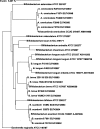Site and clinical significance of Alloscardovia omnicolens and Bifidobacterium species isolated in the clinical laboratory
- PMID: 19641056
- PMCID: PMC2756926
- DOI: 10.1128/JCM.00555-09
Site and clinical significance of Alloscardovia omnicolens and Bifidobacterium species isolated in the clinical laboratory
Abstract
Most of the members of the genus Bifidobacterium, including the related organism Alloscardovia omnicolens, are inhabitants of the gastrointestinal tract and oral cavity of humans and animals and have been considered nonpathogenic for humans. However, the actual site of isolation and the clinical significance of A. omnicolens and of Bifidobacterium species are unclear. This may be due in part to the difficulties in distinguishing these organisms from other genera such as Actinomyces. To determine the potential disease-causing role of these organisms, we analyzed the clinical significance of 15 A. omnicolens and Bifidobacterium isolates identified by 16S rRNA gene sequencing from a clinical laboratory. All of the organisms in this study were isolated from sterile sites or in significant numbers by standard clinical microbiological culture methods. Our 15 clinical strains fit into only four species: A. omnicolens (five isolates), Bifidobacterium scardovii (four isolates), B. longum (two isolates), and B. breve (four isolates). All five A. omnicolens isolates, one of the B. breve isolates, and three of the four B. scardovii isolates were cultured from urine at 10(5) CFU/ml. One B. scardovii isolate was from a patient with a genitourinary tract wound infection, two B. longum isolates were from abdominal wounds, and three B. breve isolates were from blood cultures. This study enlarges the spectrum of diseases and clinical sources associated with A. omnicolens and Bifidobacterium species and addresses identification problems.
Figures

References
-
- Chapman, T. M., G. L. Plosker, and D. P. Figgitt. 2007. Spotlight on VSL#3 probiotic mixture in chronic inflammatory bowel diseases. Biodrugs 21:61-63. - PubMed
-
- Clarridge, J. E., III. 2003. Occurrence of fastidious organisms identified by 16S rDNA sequencing recovered from urine relative to uropathogens, abstr. C-199, p. 138. In Abstr. 103rd Gen. Meet. Am. Soc. Microbiol. American Society for Microbiology, Washington, DC.
-
- Crociani, F., B. Biavati, A. Alessandrini, C. Chiarini, and V. Scardovi. 1996. Bifidobacterium inopinatum sp. nov. and Bifidobacterium denticolens sp. nov., two new species isolated from human dental caries. Int. J. Syst. Bacteriol. 46:564-571. - PubMed
-
- Guandalini, S. 2008. Probiotics for children with diarrhea. J. Clin. Gastroenterol. 42:S53-S57. - PubMed
MeSH terms
Substances
Associated data
- Actions
- Actions
- Actions
- Actions
- Actions
- Actions
- Actions
- Actions
- Actions
- Actions
- Actions
- Actions
- Actions
- Actions
- Actions
LinkOut - more resources
Full Text Sources
Molecular Biology Databases

